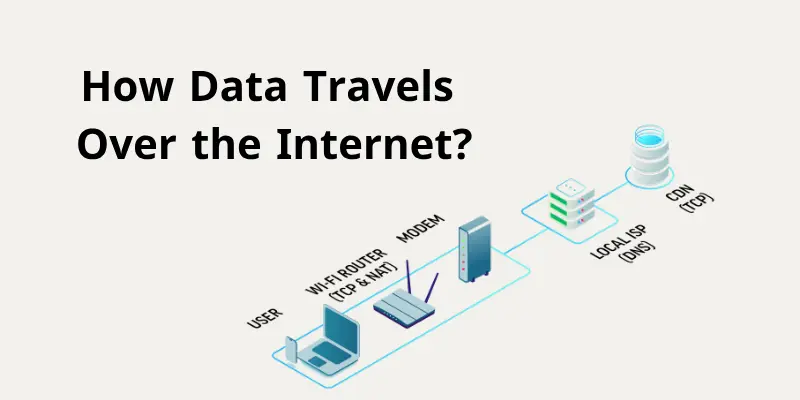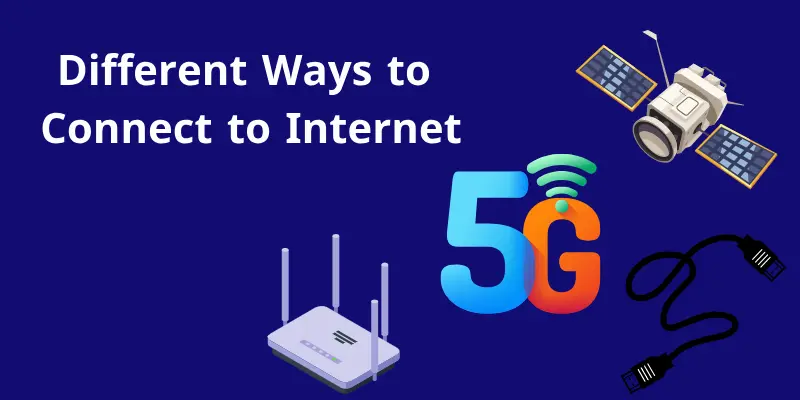How Does the Internet Work?
Published: 26 May 2025
Have you ever wondered how your favorite website loads in seconds or how you can stream videos from halfway around the world? The internet, often explained simply as what is internet in basic terms, is the invisible network connecting billions of devices worldwide, making all this possible. But how does the internet work?
This article explains how the Internet works. We’ll cover how your device connects, the protocols involved, and the security measures that keep it running. Let’s get started!
How the Internet Works: Step-by-Step
To access the internet, your device must first connect to a router or modem. This connection acts as the foundation for your internet access.
1. Connecting to the Internet
- Your device sends a request to your ISP (Internet Service Provider) when you type a web address like “www.google.com.”
- The ISP forwards this request to servers that store website data.
2. Finding the Website
- The web address is converted into a numeric format (IP address) by a system called DNS (Domain Name System).
- This IP address identifies the website’s unique location on the internet.
3. Sending a Request
- Your browser sends an HTTP request to the server hosting the website.
- The server processes this request and sends the website’s data back to your device in small pieces called packets.
4. Receiving and Reassembling Data
- Packets travel through routers and switches across the network to your device.
- Once all packets arrive, your browser organizes them (like solving a puzzle) to recreate the website.
5. Displaying the Website
- After reassembling the data, your browser displays the website on your screen.
- This entire process happens in seconds, giving you seamless access to any website!
Key Components of the Internet
The internet relies on two essential concepts: packets and protocols.

What are Packets?
- Data sent over the internet is divided into small chunks called packets.
- Packets travel independently through various devices, like routers and switches, to reach their destination.
- Once they arrive, packets are reassembled to form the original data.
Example:
When you load an image online, the image doesn’t load all at once. Small chunks of data (packets) are sent to your device, where they combine to display the complete image.
Key Points About Packets:
- Travel via cables, radio waves, or satellites.
- Contain about 1,000–1,500 bytes of data.
- Ensure efficient data transfer through a process called Packet Switching.
What are Protocols?
Protocols are standardized rules that enable devices to communicate effectively. Here are some key ones:
- IP (Internet Protocol): Assigns unique addresses to devices and routes packets.
- TCP (Transmission Control Protocol): Ensures packets are delivered in the correct order.
- HTTP/HTTPS (HyperText Transfer Protocol): Manages the transmission of web content, with HTTPS adding encryption for security.
- UDP (User Datagram Protocol): A faster alternative to TCP, commonly used for live streaming and gaming.

How Data Travels Over the Internet
When you send a message or load a webpage, data is broken into packets. These packets travel through multiple routers, switches, and servers before reaching their destination.
Simplified Breakdown:
- Packet-Switching: Packets take the most efficient route to the destination, even if that means traveling different paths.
- Protocols (TCP/IP): TCP ensures packets arrive intact and in order, while IP handles addressing and routing.
Analogy:
Imagine sending parts of a puzzle through the mail. Each piece (packet) takes a different route but eventually arrives at the same destination, where it’s reassembled into the full puzzle.

Different Ways to Connect to the Internet
The type of connection you use depends on your location and ISP. Here are the most common methods:
1. DSL (Digital Subscriber Line)
- Uses telephone lines but allows simultaneous internet and phone use.
2. Dial-Up
- An older, slower method requiring a dedicated phone line.
3. Cable
- Offers faster speeds using cable wires, independent of TV subscriptions.
4. Satellite
- Connects wirelessly via satellites, ideal for remote areas.
5. 3G/4G/5G Networks
- Wireless options for mobile devices, widely available through cellular providers.
Internet Security: Protecting Your Data
As the internet grows, so do cybersecurity challenges. Here are some key measures and best practices:
1. Encryption
- Protects your data by converting it into unreadable formats.
- Example: HTTPS secures the communication between your browser and websites.
2. Firewalls
- Act as barriers that filter incoming and outgoing traffic, blocking malicious activity.
3. VPNs (Virtual Private Networks)
- Encrypt your internet connection and hide your IP address, enhancing privacy.
4. Best Practices for Users
- Use strong, unique passwords.
- Enable two-factor authentication (2FA).
- Regularly update your software and antivirus programs.
The Future of Internet Technologies
The internet is constantly evolving to meet the demands of a connected world. Here are some trends shaping its future:
1. 5G Networks
- 5G offers faster speeds, lower latency, and higher capacity.
- It will enable advancements in IoT (Internet of Things), autonomous vehicles, and smart cities.
2. Artificial Intelligence (AI)
- AI optimizes internet traffic, enhances security, and improves user experiences through personalized recommendations.
3. Quantum Computing
- Quantum computing promises unprecedented processing power, revolutionizing data encryption and scientific research.
4. Decentralized Internet
- Emerging technologies like blockchain aim to create a decentralized internet, reducing reliance on centralized servers and improving data privacy.
5. Satellite Internet
- Companies like Starlink and OneWeb are deploying low-Earth orbit satellites to provide high-speed internet to remote areas worldwide.
6. Cybersecurity Innovations
- Advancements in AI-driven security systems and quantum encryption will strengthen defenses against evolving cyber threats.
Conclusion
Understanding how does internet works helps us appreciate the technology that connects the world. From packets and protocols to security and infrastructure, every element plays a crucial role in keeping the internet running efficiently. As technology advances, the internet will continue to evolve, shaping our digital future in ways we have yet to imagine.
Don’t forget to share your thoughts or questions in the comments below!
FAQs
Here are some common questions and answers to help you understand the basics of how the internet functions.
A global network of computers and devices that share information using standardized communication protocols.
Data travels in small packets through a network of routers, servers, and cables before reaching its destination.
A unique identifier is assigned to each device on the Internet, allowing it to send and receive data.
The Domain Name System translates website names into IP addresses, making it easier to access websites.
Through encryption, firewalls, and secure protocols like HTTPS, the internet protects data and ensures safe communication.
A router connects your local network to the internet, directing incoming and outgoing data to the correct devices.
Bandwidth is the maximum amount of data that can be transferred over an internet connection in a given time. Higher bandwidth means faster internet speeds.
While global outages are rare, major issues with DNS providers, undersea cables, or cyberattacks can cause widespread disruptions.
Latency refers to the delay before data begins to transfer after a request is made. Lower latency means quicker response times—important for gaming and video calls.
Websites are hosted on servers that run continuously, often in data centers with backup power, redundant networks, and constant monitoring.

- Be Respectful
- Stay Relevant
- Stay Positive
- True Feedback
- Encourage Discussion
- Avoid Spamming
- No Fake News
- Don't Copy-Paste
- No Personal Attacks

- Be Respectful
- Stay Relevant
- Stay Positive
- True Feedback
- Encourage Discussion
- Avoid Spamming
- No Fake News
- Don't Copy-Paste
- No Personal Attacks





